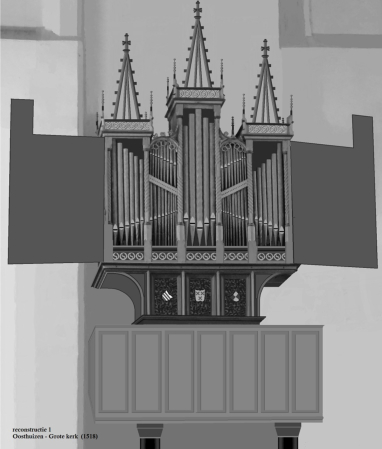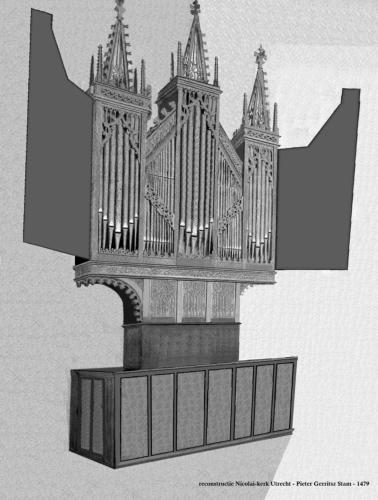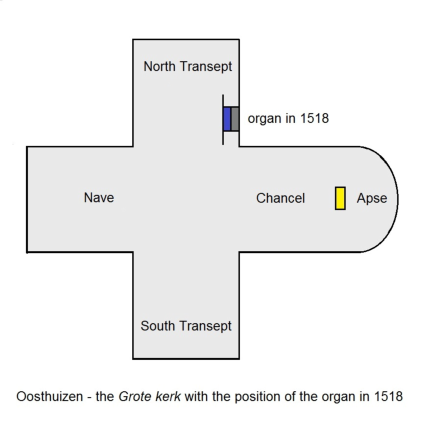The gothic organ of Oosthuizen, a reconstruction
The first time I visited the organ of the Grote kerk in Oosthuizen I wondered on the first view why it did not look like a very old organ, or even a very gothic organ. The Oosthuizen organ is special because it did not change very much in the exactly 500 years it is standing in this church, which has by the way the same age. Problematic however is the presence of elements on top and around the case that are not gothic at all and make it almost impossible to visualize a gothic style instrument. So I decided as an experiment for myself to edit one of the photos made by me in a way that made the original situation visible as much as possible by removing later added parts. This article reports an historical investigation and an attempt to give the Oosthuizen organ its face back.the case anno 2019
Three parts of the case are added on a later date: towertop, balustrade and the carved pipe shades. The huge crowning of the three towers is in Renaissance style, having pilars with round arches, timpana, obelisks and bulb ornaments, and was added probably around 1680. The height of it shows no relation with the modest dimensions of the casing itself. The balustrade from 1870 is a flat plate of wood painted in trompe d’oeill technique. The same wood color was painted on the entire organ. The carved pipe shades of the topside and the bottom of the three towers are for a number of reasons not original: The overall style of the carvings is baroque and not gothic. It has been nailed to the towers on rough wood slats, in accordance with the rather gross way the rebuilding in 1680 was executed. The line of sight of the labia and styles of the casing is not continued very well in the carvings. Moreover the carvings on the topside are too small and show too much open space; this is somewhat hidden by the extension of the pipes later on. Taking into consideration the great amount of care for details and proportions of the original case, this woodcarving can’t be from 1518. In addition: the semicircular styles on the topside of the pipe fields between the towers have a number of chained rings for decoration. (see image) These rings are connected with the style in such a way they must be orginal: a supposed combination in the original design of the rings and the baroque carvings next to it is quite impossible. Notice the difference of the way the rings are attached to the style and the way the carved shades are. Even more there are on top of the semicircular styles crockets visible, typical gothic ornamentation, what emphasizes its gothic origin. Originally there were four crockets on both sides, but the ones next to the main tower are broken. The organ has a flat case in gothic style, built in a very expensive way: twisted columns, three panels with intricate vine carving combined with shields and complex profile lists. The wood carver even allows the vines to “grow” outside the panel. (image left) On top every tower has still the four original gothic pinacles and the horizontal styles carved with mouchette tracering in between. A less expensive and more common way to decorate an organ casing was to have the decoration painted on the wood, like the organ of Scheemda (1526) has. In Oosthuizen however all decorations are designed and executed the most costly way: the twisted cannelures on the pilars are made by hand and not on the lathe. The interruption of the twist at some places by returning to the classic vertical cannelures and again going back to the twisted version makes it very clear. (image left) Moreover the carving on the outside posts is done only on a quarter of the post, only possible by hand. Because the hinges of the heavy shutters had to be on these two posts, this was the only way. Apparently the complete omission of carvings on the two posts was no option. Shutters in these time were made of massive oak boards, so the present thin shutters are from a later date. The original ones probably had valuable paintings as everything on this organ is priceless. related gothic organs Once completely stripped from all later additions and crowned by a standard gothic spire between the pinacles, the resemblance with the Nicolai organ of Utrecht by Pieter Gerritsz was obvious. To enhance this the Nicolai organ was stripped of the modifications made: the rugpositief was removed and the middle tower became flat again. On the high quality photos of Elly Kooiman, - www.ellykooiman.com/orgel/kerk middelburg koorkerk.htm [photo hoofdwerk] -, the raising of the middle tower by cutting the styles on both sides and placing extensions in between is clearly visible, thanks to the removal of the original colors by the Rijksmuseum in Amsterdam. Therefore the middle towers were lowered and accordingly the styles between the towers. Two shutters were added. The result (images left) is a kind of family picture: de resemblance between the organs of Oosthuizen and Utrecht is clear. What increases the likelihood of Gerrit Pieterszoon Stam of Utrecht being the builder of the Oosthuizen organ. about the color What remained in the reconstruction was the color: which was the original color of the case ? Inside the organ I found by chance a lump of paint: it was old, blue gray with lots of crackle, the latter a characteristic of oil paint. After that I found a complete style with peeling grey blue paint. At the beginning of the16e century the oil paint technique was still new and thats why only a limited number of colors were available. The color red, associated with blood, martyrs and war, as well as yellow - for hate and treason - were not applicable to major church furniture. But the color blue very well: blue was the color of heaven, of the water to baptize, of the Holy Virgin Mary and of the nobilty, whose blood supposedly was blue as well. It was the color of the highest rank and its dye was expensive. Two kinds of blue pigment existed: Azurite voor azure blue and Lapis Lazuli for ultramarine. Both colors were expensive, but Lapis Lazuli was ten times more expensive than Azurite and its price exceedet the price of gold. So azurite blue was used. From that point of view the Scheemda orgel turned azure blue with guilded parts. And the detailed photos of the Nicolai organ clearly show this organ to have been blue. The use of white lime as a primer on the Nicolai organ caused the blue paint to be absorbed in the lime and that way to penetrate deep into the wood: so it was impossible to remove. Because Azuriet provides a good surface to apply gold blue is found on the carved pipe shades also. A beautiful exemple of this azure blue with gold combination is the organ in Lodi (Italy,1501), were even the pipes are azure blue ( Lodi - Tempio civico della beata Vergine inco-ronata) reconstruction number two It was impossible to color the black and white picture of Reconstruction 1; so to be able to apply the color the case was measured and drawn. The drawing was colored in with blue and the de profile lists are guilded like Scheemda. The shutters consist of one piece and are decorated with paintings from the Flemish school with on the right side the Holy Family by Schongauer and on the left Saint John by Memling, both paintings from the end of the 15th century. The choice of Flemish painters is obvious: the person who ordered the construction of the organ lived in Bois-le-Duc in Brabant and she and her husband had many relations in and around Brussels. The outside of the shutters are plain blue with gold striping. The three shields in the reconstruction are covered with the most obvious coats of arms: the middle and most important shield has the coat of arms of lady Maria van Zevenbergen (1460- 1529), at that time Lady of Oosthuizen. She ruled Oosthuizen for 54 years and paid personally for the new church, church bell and organ. On the right the coat of arms of Heemskerk: a rampant silver lion on an azure blue shield, the coat of arms of lady Meyn van Heemskerk, the grandmother of Maria van Zevenbergen from whom she inherited Oosthuizen. The Heemskerk family governed Oosthuizen from 1280. On the left side the coat of arms of Cornelis van Bergen, husband of Maria; together they managed their many possessions. His coat of arms includes the coat of arms of the dukes of Brabant - a rampant golden lion on a black shield - because his family, the Glymes family, was related to the dukes. Cornelis was a knight of the order of the Golden Fleece, marshal and together with his brother Jean counsellor for the emperor in Brussels. He died in 1509 before the church in Oosthuizen was completed. Compared to the coats of arms on the choir organ of the Saint Laurens church in Alkmaar, the shields in Oosthuizen, hanging from the branches, are modestly executed. The fassade has 53 pipes; twelve of them are embossed with ornamental patterns and guilded; four pipes have only their feet ornamented. Gilding and embossement are another indication money was no issue in the building of the Oosthuizen organ. the original place of the organ Pieter Backer relocated the organ around 1680 to the west side of the church in order to make the organ suited to leading the singing. However originally the organ in Oosthuizen had no liturgical function; because Oosthuizen was a little village, the organ was probably played incidentally by organists from Hoorn of Alkmaar. Because of the modest dimensions of the chancel the placement of the organ there is not evident; optical as well as in terms of volume it would have been too dominant. Almost certain the organ stood at the North side of the church, to be exact at the East wall of the North Transept (see image), the same location were in the Cathedral of Utrecht the main organ had its place. From the nave the organ was clearly visible without dominating and with enough space for its sound. Remarkable is the absence at present of a window on this spot of the wall. And the Stam organ fits with opened shutters with a dimension of 4.5 metres exactly between the two pilasters of the wall. In the reconstruction the organ is shown on this location in the church (see image), supported by two columns like the Scheemda organ. Presumably the organ was accessible by a spriral staircase as was the situation with the new organ of the main church in Hoorn built by Gerrit Stam in 1497. The staircase is not in the reconstruction. notes on the image The existing baroque carvings were in the reconstruction repaced by gothic carvings, similar to the Nicolai organ, the old Bavo organ and the small organ of the Jacobikirche in Lübeck (Germany). The horizontal decoration on top of the towers was repeated at the bottom of the towers, as is the case in the Saint Valentinus church in Kiedrich (Germany). Finally the wooden styles of an indefinable style and indistinct making (see image), separating the two rows of pipes in between the towers, were replaced by a simple straight style like Scheemda. These fillings in the reconstruction are necessary and defendable, but a choice anyway and therefore replaceable by other choises. The reconstruction of the organ of Oosthuizen did mingle with some research into the history of the estate or fief of Oosthuizen as well as the Heemskerk and Zevenbergen family and their descendants until 1612. This history has not yet been published, but contributed to the conclusion: The organ of Oosthuizen was build in Utrecht and set up in Oosthuizen in 1518 by Gerrit Pieterszoon Stam, organbuilder of the cathedral and the parish churches in Utrecht. Gerrit repaired in1495-1496 the cathedral organ of Bois-le-Duc under supervision of the onder Brotherhood of Our Lady. Maria van Zevenbergen lived in Bois-le-Duc and did join this mighty brotherhood together with Cornelis; with their status, experience and funds they must have had great influence and probably had contact with Gerrit. The contact with this Brotherhood and the reputation of his organ in Hoorn could have provided Gerrit with this order, but there is as well a possibility he worked for Maria and Cornelis before. Maria van Zevenbergen did manage the organisation and finance of the building of the new church in Oosthuizen herself. Not surprisingly considering the fact she took care of five estates: Oosthuizen, Nieuwkoop, Noordeloos, Zevenbergen and the isle Terschelling and all those estates had churches which also were her responsability. On top of that she took care of her large villa in the town Bois-le- Duc, the castle of her family in Zevenbergen, the Heemskerk castle, the little castle of Noordeloos which once belonged to her grandmother and the castle of Heeswijk-Dinther. Her husband Cornelis also owned a number of estates and castles. The managment of all that by bailiffs (deputies) and stewards, with the help of builders, lawyers, attorneys, sollicitors and her own staff of secretaries, scribes and messengers required an archive. This archive was eventually located at the Zevenbergen castle, were Maria lived after the death of Cornelis and died herself in 1529 as did her son Cornelis (II) after his abdication as prince bishop of Liège. The castle was taken and set on fire in 1573 by rebels with probably the destruction of part of the archive. The archive or what was left of it was after the sale of the castle moved to Brussels. But again part of the Zevenbergen archive was destroyed, this time by fire, caused by the infamous bombardment of Brussels in August 1695 by the French army of Louis XIV, which ruined the entire centre of the city. There is a distinct possibility no documents concerning the building of the organ of Oosthuizen still exist. Rob van Haarlem page top

















